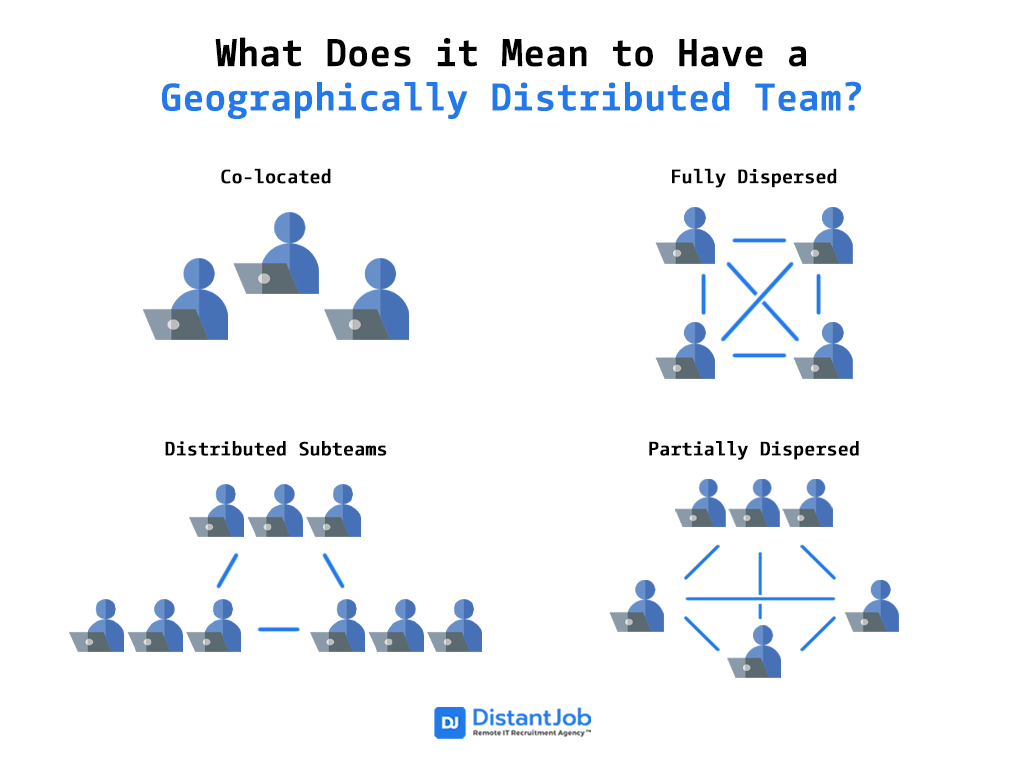There are two types of remote managers: Those who were forced to adapt to a remote work environment and manage a dispersed workforce due to the pandemic, and those who’ve been working and managing a remote team for years like us.
Regardless of what group you belong to, managing people from far away has its challenges.
A Harvard study suggested that most managers struggle to manage a team that’s spread out in many locations, with one-third of them (29%) questioning whether their employees had the required knowledge to do their work, and more than one-quarter (27%) agreeing their employees lacked essential skills.
So, what are the best practices for managing a remote team successfully? It’s all about building that sense of trust and company culture when your team is spread across different continents.
This article shares the lessons I learned running my remote business for more than 15 years, providing practical tools and tips to manage your distributed team.
What Does it Mean to Have a Geographically Distributed Team?

A geographically distributed team refers to when a company’s employees or team members are not working in the same space.
This includes hybrid arrangements as well, wherein certain employees operate entirely remotely while others are situated in a shared physical location. The term also applies to scenarios in which team members alternate between working on-site and remotely.
How to Manage a Dispersed Workforce—7 Actionable Tips
How do you manage a dispersed workforce? While there’s no one-size-fits-all formula for everyone as team dynamics are different, I can tell you one thing: Replicating the same onsite processes to virtual environments is a huge mistake.
Here’s how you manage right:
1. Focus on Results, and Give Your Workers More Autonomy
Instead of micromanaging, trust your team to complete tasks on time. You can give them responsibilities without hovering. If things do not go well, you can give feedback during your next check-in.
A survey from Harvard Business Review showed that 58 percent of managers do not trust their remote employees! If you think you are experiencing this problem alone, think again. The key is to find that sweet spot between oversight and independence.
So stop thinking about working hours. Start trusting, stop measuring time, and realize that connection to your business cannot be a secondary consideration.
2. Set Up Clear, Detailed Communication Processes
Communicate policies that describe what tool to use for what purpose. For example, use Zoom or Teams for urgent meetings, chat like Slack for short messages, and email for long messages. Some prefer communicating over emails or whiteboards, at the end of the day is what works for you and your team. But it’s important you have this well-defined so your employees always know where they can reach out to you and how.
Clear policies and communication expectations. Additionally, within this communication aspect, I always advise entrepreneurs that it really starts from the beginning: hiring. Make sure you hire people who have solid communication skills, regardless of what their role is.
3. Increase Social Interaction
Out of sight should never mean out of mind.
A Zippia report showed that in 2022, 50% of remote employees experience loneliness at least once per week. 19% mentioned that isolation is their #1 problem at work, and 70% feel left out of their workplace.
So start setting up some online events, such as happy hours, game events, and even water cooler chats. Also, check in with them from time to time to gauge their personal progress.
4. Create a Stronger Company Culture
Company culture, which is often mistaken by beer pong games and company retreats, it’s much more than fun activities. At its core, company culture is establishing connection. If you don’t prioritize building a healthy company culture in your remote team, chances are you’ll have a high turnover rate.
Create a team that is always present, looking out for each other. This can be done with virtual water cooler channels for team bonding, and regular knowledge sharing sessions that build connections across time zones.
You’re not just creating workflows; you’re building lasting remote cultures that empower teams to do their best work, no matter where they are.
5. Set Up Proper Documentation
This is the true magic of running a remote company. Creating one place where employees can access all their answers means they do not need to wait for others to respond.
Have full documentation for each worker regarding how to bring them on board, how to use tools and the processes they need to follow. Place all your documents in a project management tool such as Coda, Basecamp, or Jira, and ask your employees to update and improve them as they change.
Next, always be clear on your schedule and encourage them to do the same. What hours will you be available? What hours are you doing deep work? This will help them know when they can reach out to you.
6. Focus on Measurable Productivity Objectives
Set up proper goals and key performance indicators (KPIs), so workers know what you expect them to achieve. Instead of using online presence as a measure, use these measures to evaluate worker productivity.
The key lies in setting clear expectations and goals, allowing team members the flexibility to manage their time and work in a manner that suits their strengths and preferences.
Do weekly meetings where you check on the progress of projects and discuss what has been done, what has not been done, and how the worker plans to solve any issues.
7. Establishing Robust Security
73% of executives believe that remote work involves having a greater security risk. This may be true if you don’t have robust security protocols.
Start with employee education on security practices—from password management and secure Wi-Fi usage to VPNs, device updates, and the establishment of clear remote access policies and incident reporting procedures. Following this, having skilled developers elevates your security protocols to the next level.
What are the remote management challenges?
1. Performance Tracking
67% of managers report difficulty in accurately measuring remote productivity without micromanaging.
For some leaders managing an onsite team is easier. They can argue about teams being more productive or present, but the truth is that it all comes down to trust. If you’re used to lurking in your employees’ work, wanting to be on top all the time, managing a virtual workforce can be a nightmare for you.
2. Team Connection
89% of remote workers feel less connected to their teammates. Building trust and maintaining company culture becomes 3x harder in virtual settings.
For example, in my team whenever we need to discuss relevant topics or urgent matters we always do this by Zoom. We also record the meetings and we transcribe them in case we want to go individually by some of the key points.
3. Work-Life Balance
Remote employees work an average of 3 more hours per day, leading to burnout in 42% of cases. Managing boundaries becomes increasingly complex across different time zones. Being away from coworkers can cause all kinds of strain on employees’ mental and emotional wellbeing. Mostly because not all employees are the same. Some may love working alone from home, but others might miss the social aspect of the office.
4. Technology Barriers
71% of remote teams face technical issues weekly, from poor internet connectivity to incompatible software systems, causing an average 4-hour productivity loss per week. Without strict policies and education, dispersed teams can inadvertently expose sensitive data.
Final Challenge: Hiring the Right People
Managing a dispersed team effectively comes down to balancing trust, communication, and clearly defined processes.
But one thing is for sure, if you don’t have the right people on your team, obstacles will be much harder to overcome. To overcome the challenge of hiring the right talent, consider looking for individuals who are career-driven, result-oriented, and possess strong communication skills. Seeking these qualities in potential geographically distributed team members can significantly contribute to building a successful remote workforce.
Having managed a remote company for more than a decade I know how difficult it is to hire the right talent. This is what drove me to create the first IT remote recruitment agency, that not only focuses on finding the right talent for your team but also on providing ongoing HR support.
Want to know more? Let’s talk!






